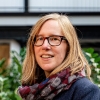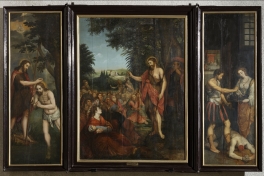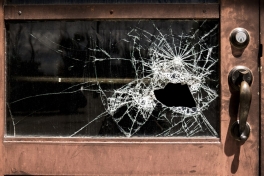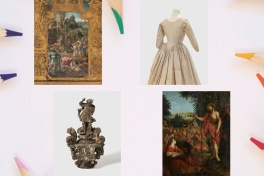Preventieve conservatie en depotwerking
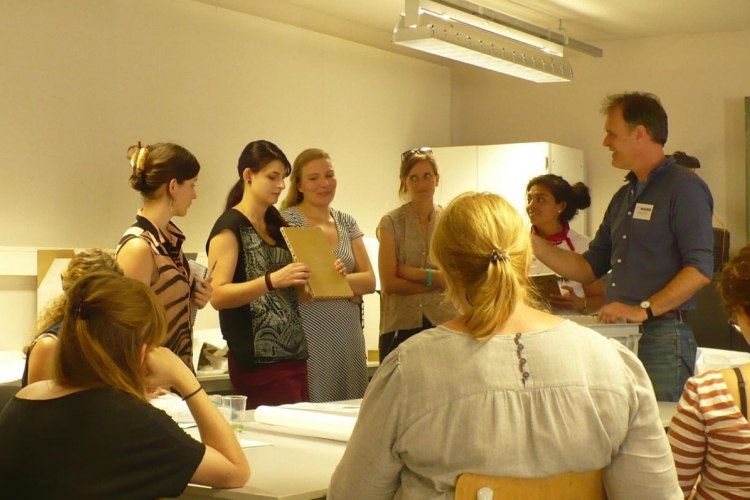
Dag 2 van de summer school was gewijd aan ‘Preventieve conservatie en depotwerking’. Martijn De Ruijter, werkend in het Nationaal Museum van Wereldculturen en lesgever in collectiemanagement in de Reinwardt Academie, gaf een introductie over preventieve conservatie van etnografische objecten in musea. Hij begon met de potentiële risico’s, namelijk de tien schadefactoren. Hij gaf voorbeelden van interessante handreikingen zoals ‘Benchmarks in collection care 2.0.’en ‘Re-ORG’ en lichtte deze kort toe.
De studenten werden hierna in groepjes verdeeld en kregen de opdracht om het klaslokaal te reorganiseren. Eerst moesten ze hiervoor het klaslokaal opmeten en op schaal tekenen. Ze kregen verschillende kleurstroken uit papier die elk een ander soort kast of rek voorstelden. Deze moesten op een zo goed mogelijke manier in de ruimte geschikt worden, rekening houdend met de tien schadefactoren en het inperken van ruimteverlies. Na de koffiepauze was er tijd voor discussie en elke groep stelde zijn plan voor. Na uitleg over de depotruimte gaf Martijn De Ruijter les over de verschillende verpakkingsmaterialen en -methoden.
In de namiddag bezochten de studenten het Hessenhuis. Dirk Aerts gaf eerst kort wat uitleg en gaf samen met zijn collega een gegidste toer doorheen het depot. Zo konden de deelnemers de etnografische collectie van kortbij bekijken. Hierna werd via het FelixArchief naar het MAS gewandeld en werd er een rondleiding gegeven in het kijkdepot en de restauratieruimte.
Na een lange dag was er nood aan een stevige maaltijd om terug energie te krijgen vooraleer de avondcolleges startten. Violette Demonty en Sophie Genin, masterstudenten conservatie-restauratie van La Cambre Brussel stelden hun project voor in Kinshasa en lichtten toe hoe om te gaan met depotwerking in een ongunstige omgeving en met weinig middelen. Jürgen Vanhoutte, stafmedewerker van FARO, gaf toelichting bij de Re-ORG methodologie en het Re-ORG project in België. De dag werd afgesloten met de presentatie van Lucie Monet van het Etnografisch Museum in Genève (MEG) over het nieuwe museumgebouw en de methode van aanpak voor de verhuis van hun collectie.
Omdat het MEG ook een grote Europese collectie heeft, kwam een interessante discussie op gang. Wat is het verschil tussen ‘Volkskunde’ en ‘Volkenkunde’? Ook een studente antropologie lichtte toe dat zij het raar vond dat hier in België etnografische collecties gerelateerd worden met niet-Europese collecties. Etnografische studies is immers een onderzoeksmethode, gericht op het bestuderen van groepen mensen in relatie tot hun cultuur.
Van 24 tot en met 30 augustus liep in Antwerpen de summer school ‘Etnographic collections, preservation, research and conservation'. Deze summer school werd georganiseerd door de opleiding Conservatie-Restauratie (Faculteit Ontwerpwetenschappen) van de Universiteit Antwerpen en kwam tot stand in samenwerking met Etnocoll, het platform van Belgische instellingen met een etnografische en niet-Europese collectie, gefaciliteerd door de Koning Boudewijnstichting en FARO. Vlaams steunpunt voor cultureel erfgoed vzw. FARO-medewerker Julie Lambrechts bracht dagelijks verslag uit. Lees hier alle blogberichten over de summer school.
English version
Day 2 of the summerschool was focused on ‘Preventive conservation and storage’.
In the morning, Martijn De Ruijter, working at the National Museum of World cultures and teacher in collections management in the Reinwardt Academy, gave an introduction to preventive conservation of ethnographic objects in museums. He started with potential risks, the 10 agents of deterioration.
He gave some examples of interesting guides like ‘Benchmarks in collection care 2.0.’, a self-assessment checklist which sets out clear and realistic benchmarks for the care of collections. And ‘Re-ORG’, a platform with tools for Museum storage reorganizing. After the lecture the students were put in groups and were instructed to reorganize the classroom. They had to measure the room and got different colored papers cut in scale that presented the different kind of storage racks. Those needed to be reorganized in the best possible way taking in account the 10 agents of deterioration and to minimize the loss of space. After the coffee break there was time for discussion and every group presented their plan of the storage room. To finish Martijn De Ruijter gave lecture about desired storage and packaging materials. He showed different materials and packing systems to the students.
In the afternoon the students visited first the ‘Hessenhuis’. Dirk Aerts gave an introduction and together with his colleague he gave a guided tour in the storage room. The students had the opportunity to see the ethnographic collections in storage. We had a walk true the FelixArchief and visited the open storage room and the restoration studio of the MAS.
After a long day we all had dinner together to re-energize for the evening classes.Violette Demonty and Sophie Genin, master students Conservation Studies in La Cambre, Brussels gave a lecture about their experiences in Kinshasa. How to deal with storage in unfavorable conditions and little money. Jürgen Vanhoutte, staff member of FARO presented the Re-ORG methodology and the Re-ORG project in Belgium. To end the day Lucie Monet from the Ethnographic Museum of Geneva (MEG) gave a presentation of the storage of the ethnographic collection, the plan of the new museum building and the working method to achieve the collection move.
Because the MEG mentioned they also had an European collection, an interesting discussion came about what the difference is between ‘Volkskunde’ and ‘Volkenkunde’. Also a student in anthropology explained that for her it is really strange that in Belgium ethnographic collections are non-European collections. Because ethnography is the systematic study of people and culture.

